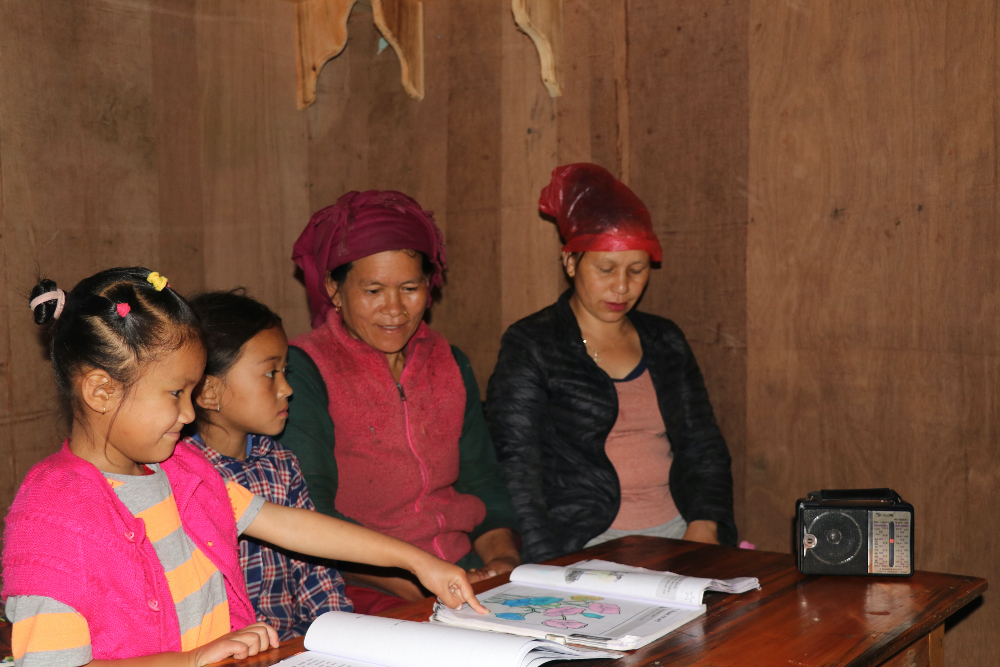Schools of the Air

For nearly 18 months, regular educational activities of children across Nepal have been disrupted. The closure of schools to reduce the spread of Covid-19 has amplified the many other ways the pandemic has eroded the academic and social experiences of students, and with this, their mental wellbeing.
The impact of this will be felt for many years by the students themselves and nationally, as Nepal’s economy, like other countries, witnesses a reduced rate of economic return.
Children from poorer families and those in remote parts of Nepal have been especially affected. The pandemic has laid bare inequality in access to education.
The Nepal government’s Students’ Learning Facilitation Guidelines 2020 notes that a large number of students do not have access to innovative delivery of distance learning rograms. Rather, they depend on the distribution of printed learning materials and person-to-person contact that has been difficult to sustain during the pandemic.
Even before Covid, Australia and Nepal shared challenges with the delivery of education to students living in remote locations.
In the central desert area of Australia is the Alice Springs School of the Air (ASSOA), reputedly the biggest school in the world. ASSOA's classrooms are spread over 1.3 million sq km, yet it has only 120 students and 14 teachers.
For over 60 years, it has been delivering education by radio for children who live a day’s drive or more from the nearest school. ASSOA is one of several Schools of the Air operating across the vast Australian outback.

So it should come as no surprise that during the pandemic Australia has been supporting the delivery of education to children in rural Nepal.
The Australian government has partnered with Rural Education and Development Center (REED) Nepal to deliver a program that is enabling continued learning in the far reaches of Nepal.
The Promoting Stability in Education (PSE): Continuity of Learning and Strengthening Resilience program builds on the experiences of REED’s successful Teacher Training and Quality Education Program in Solukhumbu district, supported by the Australian Himalayan Foundation.
Parents, teachers, community volunteers and local governments are working together to encourage and ensure children’s access to learning opportunities in communities that have limited access to the Internet.

Under this initiative, lessons are broadcast daily through local radio stations to over 23,000 households, reaching over 66,000 children and 14,000 parents. Radio sets, worksheets and other educational materials are being distributed to children’s families. The program will assist the transition back to in person classroom learning when schools reopen.
Nearly two months after the launch of the program, PSE has been warmly received by students and educators alike.
Bahjang Secondary School student, Pramila Ratala, who lives with disability, has welcomed the way Learning by Radio has brought her school to her home.
“I used to walk two hours to go to my school but nowadays, I am learning from my home,” she said. “In addition to regular school curriculum, I also learn life skills and issues of gender equality. In future, I want to work for the benefit of children with disabilities and be like the award-winning author Jhamak Ghimire.”
Through PSE, educators visit homes, distributing learning materials and radio sets to families and providing support to parents and community members.
Local governments are closely engaged in the program. Education representative of Haleshi Tuwachung Municipality of Khotang district, Padam Karki said, “With the federal government’s decision to close schools, we were quite worried about what we could do to ensure we backstop learning loss among our children”.
“Learning by Radio is instrumental in continuing education for our children. We are ready to cooperate with the program by visiting households and interacting with the parents and other stakeholders of children’s education, distribution of radio sets, workbooks and worksheets, and mobilising volunteer teachers,” Karki added.
The benefits of programs like Learning by Radio, are not confined to Covid; rather, they provide innovative learning models for all who have difficulty accessing traditional education due to disabilities or their remote location.
As Keshari Rai, a teacher from Janajagriti Basic School in Dudhkunda, Solukhumbu observed, “There is very limited access to smartphones and reliable internet. Children have to walk a long distance to come to school every day.”
Delivery of pre-recorded educational materials also benefits parents and local communities ith information relevant regardless of age. Ishori Nepali from Talkot Rural Municipality, Bajhang district, said she found her child’s radio lessons on gender equality and life-skills useful to her as well and she has become a regular listener.
Barun Lamichhane, station manager of Beats FM, Sindhuli, agreed that Learning by Radio has applications beyond the formal education setting. “The program has helped deliver life-skill education and public service announcements including information on pandemic, gender issues and disaster preparedness."
From Australia’s cattle stations to Nepal’s Himalayan communities, students and their families are benefiting from schools of the air. For all the challenges Covid-19 has presented, it has also reminded us that old technologies combined with new thinking can help chart a more positive future.
Felicity Volk is the Australian Ambassador to Nepal.




